Class notes
Statistics Notes
- Course
- STAT72105
This business statistics course covers simple descriptive statistics, probability and the binomial and normal probability distributions, statistical inference, sampling distributions, simple regression and correlation analysis.
[Show more]



